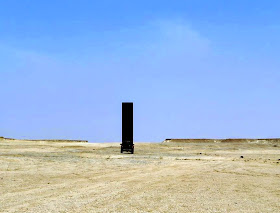East-West/West-East by Richard Serra
"…he did not simply set an artwork in a landscape but rather took account of a natural but structured space, paying exact attention to the scale of his addition to it…"
-Qatar Museums Authority brochure
You wander the desert, the sun heavy on your head. All around you is an endless field of earth and sky marching toward a horizon marked by strange mesa shaped sand and rock formations.
There is color in these mini mountains: reds, yellows and chocolate hued rock bits shaped like burned charcoal. The sand is velvet soft, light and easily carried by the wind. It collects in your ears, fills wrinkles, sneaks into your socks. Sweaty, gritty toes rub against one another and blister.
You climb a limestone plateau. Shoes disappear into the soft sand. The top of the mesa is flat, speckled with pockets of low lying green. You can see for miles in every direction.
Bob atop a limestone plateau
At one end, blue variegates from nearly white around the sun to icy blue at the place where sky meets sea. You look inland toward tiny, barely discernable bumps along the horizon that signal the village of Zekrit. Another direction reveals miles of desert brown fading into the dome above you.
At the final turn a dark thread rises out of the earth, streams heavenward. You slide down the mesa and aim that direction. The unfettered sun boils your skin, burns your eyes. You raise your arms and unsettled air shimmers in the textured atmosphere.
steel plate appears threadlike from the side
Yeah, it's hot. And there are no - none - trees. C'mon, what did you expect? You're doing walkabout in a (nearly) equatorial desert.
desert green
You slog toward the dark line and it seems to change: at first reed thin, it widens, opens, closes, flattens, at one point appears almost round.
But wait - you must be hallucinating. Two shapes, now three - is that a fourth peeking over the horizon?
You alter your approach and see that the forms are rectangular steel plates, one end buried in the sloping desert between two limestone plateau ranges. Each plate measures 4 meters by 13.5 cm. Two rise 14.7 meters into the burning, unforgiving sky while the other two soar 16.7 meters high. Due to the uneven topography each plate stands exactly the same height as the others and the surrounding mountains too. Face the end of a pillar and it's a piece of copper colored straw. Stand directly in front and the plate is wide and flat and the others disappear behind it. As you step to one side or the other, the pillars open like folds in a fan.
four plates, one car
The plates are a sculpture called East-West/West-East by artist and world renowned Man of Steel Richard Serra. The artist also created "7" - a vertical permanent structure set on a pier behind Doha's Museum of Islamic Art. Additional works are currently on exhibit at Katara and Alriwaq at MIA Park in Doha. (To learn more about Richard Serra and his work, click here: http://richardserraqatar.qa/en/)
Bob and 4 plates
A streak of rust mars the front and back of each evenly spaced pillar. Sun reflects off the steel, absorbs and transmits heat as it delineates distance in the endless field of rock and sand. On approach, just two plates are visible. Even though plates are the same height as the mountains that flank them they seem to roll up and fall back as you move forward.
"…it only takes on its full meaning when we walk its length and grasp its relationship to its site…"
-brochure
You walk the length of the exhibit, taking in the expanse of burning sand, basking in the dome of blue above and field of brown at your feet. You consider each towering copper hued structure, careful not to stand too close lest you absorb your limit of hot.
limestone plateaus
You wonder at the enormity of the project and marvel at the curiosity of four steel plates marching across the desert outback like giant rectangular Bedouins.
Finally, after a long drive, strenuous climb and sweaty wander, you shield your eyes and search the horizon. There are no "facilities" in wilderness galleries. Just sand, sky, rock, the stray shrub. You know: nature.
And - at this end of the desert, at least - steel.
East-West/West-East is located in the Brouq Nature Reserve on Qatar's thumb - a desert peninsula outside Zekrit along the country's Eastern coast. Take the Dukhan Road, exit toward Zekrit. Pass the Cuban Hospital, beyond the billowing oil wells and wind surfers…follow the road until it ends at the tiny beachside town. Now turn right and drive into the desert. Keep going until you see threads rising into the sky.
GPS Coordinates: N25°31.019'E050°51.948.








This comment has been removed by the author.
ReplyDeleteInteresting art/sculpture. Were you able to take these pictures? Some of them? Think I'll look up Richard Serra in Wickipedia before I listen to the next presentation.
ReplyDeleteYes, I took all the pictures - thanks! The link in the piece leads you to his website and more links about his art...
ReplyDeleteWell I remember Desert Hot--unyielding and unremitting, and you describe it graphically.
ReplyDeleteBut tell us about the "Cuban Hospital." That was an odd non sequitur.
Dad
:) Here's a link to The Cuban Hospital: http://cuban.hamad.qa/en/welcome.aspx. I love a good odd non sequitor - they're ribbons (to new ideas).
ReplyDelete